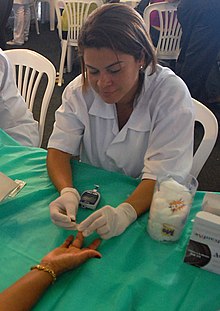|
Fingerstick In medicine, some blood tests are conducted on capillary blood obtained by fingerstick (or fingerprick) (or, for neonates, by an analogous heelprick). The site, free of surface arterial flow, where the blood is to be collected is sterilized with a topical germicide, and the skin pierced with a sterile lancet.[1] After a droplet has formed, capillary blood is captured in a capillary tube (usually relying on surface tension). Blood cells drawn from fingersticks have a tendency to undergo hemolysis, especially if the finger is "milked" to obtain more blood.[2] UsesTests commonly conducted on the capillary blood collected are:
Fingersticks are routine for hardy[citation needed] adults, but are generally performed on children and the elderly only if a small amount of blood suffices for needed tests. Neonates are given heelpricks instead, as this is less likely to cause permanent damage.[citation needed] References
External links
|
Portal di Ensiklopedia Dunia